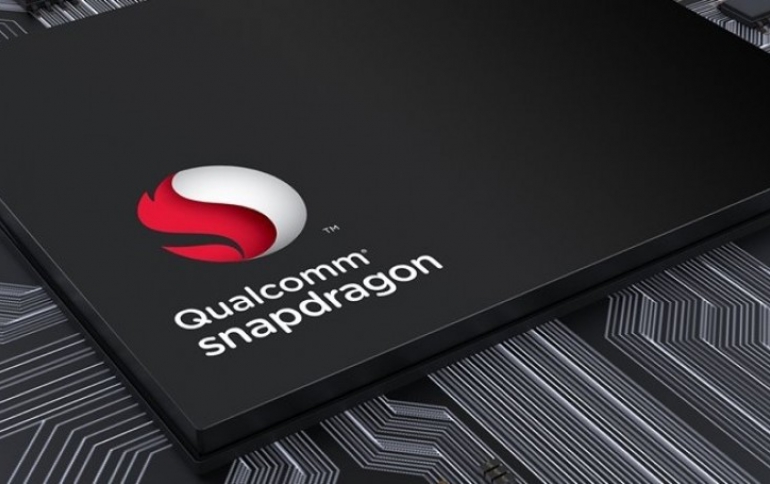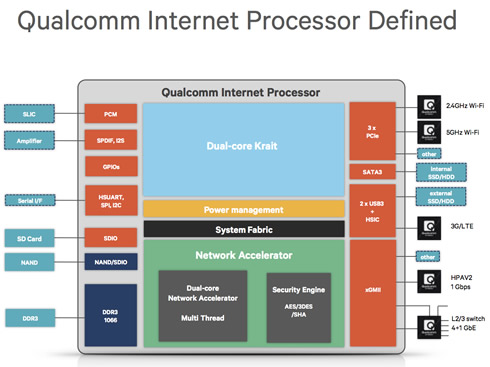
Qualcomm Unveils New Snapdragon 805, Internet And Modem Chips
Qualcomm today announced new chips for mobile and networking gadgets, including the new Snapdragon 805 processor supoports UltraHD resolutions, its fourth-Generation 3G/LTE multimode modem and RF transceiver chips along with the Qualcomm Internet Processor (IPQ) product line.
Qualcomm Snapdragon 805
The next generation mobile processor of the Qualcomm Snapdragon 800 tier, the Qualcomm Snapdragon 805 processor, hs been designed to deliver the highest-quality mobile video, imaging and graphics at Ultra HD (4K) resolution, both on device and via Ultra HD TVs.
Featuring the new Adreno 420 GPU, with up to 40 percent more graphics processing power than its predecessor, the Snapdragon 805 processor is the first mobile processor to offer system-level Ultra HD support, 4K video capture and playback and enhanced dual camera Image Signal Processors (ISPs).
The Snapdragon 805 processor is featuring a Krait 450 quad-core mobile CPU running at speeds of up to 2.5 GHz per core. It also supports memory bandwidth of up to 25.6 GB/second. Ultra HD graphics are powered by the Adreno 420 GPU, which introduces support for hardware tessellation and geometry shaders, for 4K rendering.
Either the Qualcomm Gobi MDM9x25 or the Gobi MDM9x35 modems are integrated. The Gobi MDM9x25 chipset supports LTE carrier aggregation and LTE Category 4 with peak data rates of up to 150Mbps. Additionally, Qualcomm's 2-stream dual-band Qualcomm VIVE 802.11ac Wi-Fi echnology enables wireless 4K video streaming and other media-intensive applications. With a low-power PCIe interface to the QCA6174, tablets and high-end smartphones can take advantage of faster mobile Wi-Fi performance (over 600 Mbps).
The Snapdragon 805 also supports the Hollywood Quality Video (HQV) for video post processing and introduces hardware 4K HEVC (H.265) decoding for mobiles for low-power HD video playback.
Gpixel/s throughput camera support increases the camera's speed and imaging quality. And sensor processing with gyro integration enables image stabilization.
The Snapdragon 805 processor is sampling now and expected to be available in commercial devices by the first half of 2014.
Qualcomm Internet Processor
Qualcomm's subsidiary, Qualcomm Atheros, Inc., also today introduced the Qualcomm Internet Processor (IPQ) product line to transform networking devices like home gateways, routers and media servers into "Smarthome" platforms.
The IPQ enables home network equipment to do more than deliver broadband connections. Qualcomm?s "Smarthome" platform combines Qualcomm?s dual-core 1.4 GHz Krait central processing unit (CPU), to manage functions such as demanding Internet-based applications and services, with Qualcomm Atheros' new dual-core 730 MHz Packet Processor Engine, to offload network traffic, supporting up to 5 Gbps of aggregate capacity across LTE, 802.11ac Wi-Fi, HomePlug powerline, hybrid wired/wireless, and Ethernet.
In addition, the platform offers Qualcomm security, encryption, Trustzone and secure boot to support services such as home and health monitoring.
Qualcomm claims that the 28 nm IPQ offers up to 70 percent greater performance-per-watt than the nearest competitor. The IPQ optimizes energy consumption by dynamically scaling system operation to adjust to network demands, whereas most network processors function only in on or off modes, with continuous power used in always-on gateways.

For product developers, the IPQ provides a flexible architecture and numerous media and networking interfaces to enable a full range of connected home products with different feature sets and use cases. Additionally, the IPQ's modular hardware and software design featuring a PHY-agnostic processor enables Qualcomm's customers to re-use hardware designs and software investments across DSL, cable and fiber access products. The IPQ supports major interfaces, such as PCIe, USB 3.0, SATA3, SDIO, and Gigabit Ethernet.
Qualcomm's first two solutions in the IPQ product line, the IPQ8062 and IPQ8064 for retail routers and home media servers, are currently in production and will be available in commercial products in the first half of 2014. IPQ-based gateways and enterprise access points are expected by mid-2014.
Fourth-Generation 3G/LTE Multimode Modem and RF Transceiver Chip
Qualcomm fourth-generation 3G/LTE multimode solutions include the Qualcomm Gobi 9x35 modem chipset, and an RF transceiver chip, the Qualcomm WTR3925.
The Qualcomm Gobi 9x35 is the first announced cellular modem based on the 20 nm technology node with support for global carrier aggregation deployments up to 40 MHz for both LTE TDD and FDD Category 6 with download speeds of up to 300 Mbps. The Gobi 9x35 is backwards compatible and supports all other major cellular technologies, including DC-HSPA, EVDO Rev. B, CDMA 1x, GSM and TD-SCDMA. The Qualcomm WTR3925 is the first RF transceiver chip based on the 28 nm process, and is Qualcomm Technologies' first single-chip, carrier aggregation RF solution that supports all carrier aggregation band combinations approved by 3GPP. The WTR3925 pairs with the Gobi 9x35 chipset and the Qualcomm RF360 Front End Solution to enable a single-SKU LTE platform.
The Gobi 9x35 and WTR3925 are specifically designed to use less power and occupy less printed circuit board area and continue the trend towards tighter integration, smaller size and increased performance. The 40 MHz carrier aggregation capability of the Gobi 9x35, coupled with the carrier aggregation band support of the WTR3925, is engineered to allow network operators to combine their fragmented spectrum in all possible 3GPP-approved combinations of 5 MHz, 10 MHz, 15 MHz, and 20 MHz bandwidths to increase capacity and service more subscribers. The WTR3925 also incorporates the Qualcomm IZat location platform designed for delivery global location.
Qualcomm claims that the Gobi 9x35 modem and WTR3925 chipset deliver up to 2X faster LTE Advanced, CAT 6 up to 300 Mbps, along with dual carrier HSUPA and dual band multi-carrier HSPA+.
The company anticipates that the Gobi 9x35 and WTR3925 will begin sampling to its customers early next year.
The next generation mobile processor of the Qualcomm Snapdragon 800 tier, the Qualcomm Snapdragon 805 processor, hs been designed to deliver the highest-quality mobile video, imaging and graphics at Ultra HD (4K) resolution, both on device and via Ultra HD TVs.
Featuring the new Adreno 420 GPU, with up to 40 percent more graphics processing power than its predecessor, the Snapdragon 805 processor is the first mobile processor to offer system-level Ultra HD support, 4K video capture and playback and enhanced dual camera Image Signal Processors (ISPs).
The Snapdragon 805 processor is featuring a Krait 450 quad-core mobile CPU running at speeds of up to 2.5 GHz per core. It also supports memory bandwidth of up to 25.6 GB/second. Ultra HD graphics are powered by the Adreno 420 GPU, which introduces support for hardware tessellation and geometry shaders, for 4K rendering.
Either the Qualcomm Gobi MDM9x25 or the Gobi MDM9x35 modems are integrated. The Gobi MDM9x25 chipset supports LTE carrier aggregation and LTE Category 4 with peak data rates of up to 150Mbps. Additionally, Qualcomm's 2-stream dual-band Qualcomm VIVE 802.11ac Wi-Fi echnology enables wireless 4K video streaming and other media-intensive applications. With a low-power PCIe interface to the QCA6174, tablets and high-end smartphones can take advantage of faster mobile Wi-Fi performance (over 600 Mbps).
The Snapdragon 805 also supports the Hollywood Quality Video (HQV) for video post processing and introduces hardware 4K HEVC (H.265) decoding for mobiles for low-power HD video playback.
Gpixel/s throughput camera support increases the camera's speed and imaging quality. And sensor processing with gyro integration enables image stabilization.
The Snapdragon 805 processor is sampling now and expected to be available in commercial devices by the first half of 2014.
Qualcomm Internet Processor
Qualcomm's subsidiary, Qualcomm Atheros, Inc., also today introduced the Qualcomm Internet Processor (IPQ) product line to transform networking devices like home gateways, routers and media servers into "Smarthome" platforms.
The IPQ enables home network equipment to do more than deliver broadband connections. Qualcomm?s "Smarthome" platform combines Qualcomm?s dual-core 1.4 GHz Krait central processing unit (CPU), to manage functions such as demanding Internet-based applications and services, with Qualcomm Atheros' new dual-core 730 MHz Packet Processor Engine, to offload network traffic, supporting up to 5 Gbps of aggregate capacity across LTE, 802.11ac Wi-Fi, HomePlug powerline, hybrid wired/wireless, and Ethernet.
In addition, the platform offers Qualcomm security, encryption, Trustzone and secure boot to support services such as home and health monitoring.
Qualcomm claims that the 28 nm IPQ offers up to 70 percent greater performance-per-watt than the nearest competitor. The IPQ optimizes energy consumption by dynamically scaling system operation to adjust to network demands, whereas most network processors function only in on or off modes, with continuous power used in always-on gateways.

For product developers, the IPQ provides a flexible architecture and numerous media and networking interfaces to enable a full range of connected home products with different feature sets and use cases. Additionally, the IPQ's modular hardware and software design featuring a PHY-agnostic processor enables Qualcomm's customers to re-use hardware designs and software investments across DSL, cable and fiber access products. The IPQ supports major interfaces, such as PCIe, USB 3.0, SATA3, SDIO, and Gigabit Ethernet.
Qualcomm's first two solutions in the IPQ product line, the IPQ8062 and IPQ8064 for retail routers and home media servers, are currently in production and will be available in commercial products in the first half of 2014. IPQ-based gateways and enterprise access points are expected by mid-2014.
Fourth-Generation 3G/LTE Multimode Modem and RF Transceiver Chip
Qualcomm fourth-generation 3G/LTE multimode solutions include the Qualcomm Gobi 9x35 modem chipset, and an RF transceiver chip, the Qualcomm WTR3925.
The Qualcomm Gobi 9x35 is the first announced cellular modem based on the 20 nm technology node with support for global carrier aggregation deployments up to 40 MHz for both LTE TDD and FDD Category 6 with download speeds of up to 300 Mbps. The Gobi 9x35 is backwards compatible and supports all other major cellular technologies, including DC-HSPA, EVDO Rev. B, CDMA 1x, GSM and TD-SCDMA. The Qualcomm WTR3925 is the first RF transceiver chip based on the 28 nm process, and is Qualcomm Technologies' first single-chip, carrier aggregation RF solution that supports all carrier aggregation band combinations approved by 3GPP. The WTR3925 pairs with the Gobi 9x35 chipset and the Qualcomm RF360 Front End Solution to enable a single-SKU LTE platform.
The Gobi 9x35 and WTR3925 are specifically designed to use less power and occupy less printed circuit board area and continue the trend towards tighter integration, smaller size and increased performance. The 40 MHz carrier aggregation capability of the Gobi 9x35, coupled with the carrier aggregation band support of the WTR3925, is engineered to allow network operators to combine their fragmented spectrum in all possible 3GPP-approved combinations of 5 MHz, 10 MHz, 15 MHz, and 20 MHz bandwidths to increase capacity and service more subscribers. The WTR3925 also incorporates the Qualcomm IZat location platform designed for delivery global location.
Qualcomm claims that the Gobi 9x35 modem and WTR3925 chipset deliver up to 2X faster LTE Advanced, CAT 6 up to 300 Mbps, along with dual carrier HSUPA and dual band multi-carrier HSPA+.
The company anticipates that the Gobi 9x35 and WTR3925 will begin sampling to its customers early next year.





















